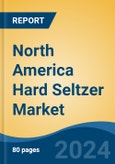Speak directly to the analyst to clarify any post sales queries you may have.
10% Free customizationThis report comes with 10% free customization, enabling you to add data that meets your specific business needs.
Millennials and Gen Z consumers, in particular, favor these beverages due to their refreshing flavors, convenience, and perceived health benefits. Also, the growing trend of on-the-go lifestyles has boosted the demand for ready-to-drink (RTD) alcoholic beverages, further propelling the market. Innovations in flavors and product variety by key players also contribute to attracting a broader consumer base. Also, expanding distribution channels, including e-commerce and retail outlets, have made hard seltzers more accessible, fueling market growth across North America.
Key Market Drivers
Rising Consumption of Alcoholic Beverages Across the Region
The rising consumption of alcoholic beverages across North America is a key driver fuelling the hard seltzer market’s expansion. As a part of this, according to the 2023 National Survey on Drug Use and Health (NSDUH), 224.3 million individuals aged 12 and older - representing 79.1% of this age group - reported having consumed alcohol at least once in their lifetime. Increasing social acceptance and changing lifestyle patterns have encouraged more consumers to explore diverse alcoholic options, including hard seltzers. The shift towards casual and social drinking occasions, especially among younger demographics such as millennials and Gen Z, has led to a surge in demand for light, refreshing, and easy-to-drink alcoholic beverages.Hard seltzers, known for their low alcohol content, fewer calories, and variety of flavors, fit perfectly into this evolving consumer preference. Also, the rise of health-conscious drinking habits means consumers are increasingly opting for beverages perceived as healthier alternatives to traditional beers and cocktails. Marketing efforts by major beverage companies highlighting the low-calorie and gluten-free attributes of hard seltzers have further amplified their appeal. These factors combined have contributed significantly to the growing consumption trends of hard seltzers throughout the North American region.
Key Market Challenges
Intense Competition Among Players
Intense competition among players poses a significant challenge to the North America hard seltzer market. The rapid growth and profitability of the segment have attracted numerous established beverage companies as well as new entrants, leading to market saturation. Brands constantly strive to differentiate themselves through innovative flavors, packaging, and marketing strategies, which increases operational costs and pressures profit margins. Also, smaller craft brands often struggle to compete with large corporations that have extensive distribution networks and bigger marketing budgets.The competition also drives frequent product launches and promotions, creating volatility in pricing and consumer loyalty. This crowded marketplace makes it difficult for companies to maintain sustainable growth and retain market share. Also, the constant need for innovation requires substantial investment in research and development, which can be a barrier for smaller players. Overall, intense competition challenges players to continuously adapt and invest to stay relevant in the North American hard seltzer market.
Key Market Trends
Rising Preference for Gluten-Free and Clean-Label Alcoholic Options
The North American hard seltzer market is experiencing a significant trend towards gluten-free and clean-label alcoholic beverages, driven by increasing consumer demand for healthier and more transparent product options. Health-conscious consumers, particularly millennials and Gen Z, are seeking beverages that align with their wellness goals, leading to a preference for products with natural ingredients and minimal additives. Hard seltzers, often marketed as gluten-free and low in calories, fit well into this trend, offering a refreshing alternative to traditional alcoholic drinks. Brands are responding by emphasizing clean labeling practices, providing clear information about ingredients and nutritional content, and ensuring products meet gluten-free standards. This shift reflects a broader societal move towards mindful consumption and dietary inclusivity, positioning gluten-free and clean-label hard seltzers as a prominent choice in the evolving alcoholic beverage landscape.Key Market Players
- The Mark Anthony Group of Companies
- Boston Beer Corporation
- Anheuser Busch Inc.
- Molson Coors Beverage Company
- Hard Seltzer Beverage Company, LLC
- Coca-Cola HBC AG
- Long Ashton Holdings Limited
- Vermont Hard Seltzer
- Barbrew Beverages Pvt Ltd
- Lunar Brands Inc
Report Scope:
In this report, the North America Hard Seltzer Market has been segmented into the following categories, in addition to the industry trends which have also been detailed below:North America Hard Seltzer Market, By ABV Content:
- Equals to 5%
- Less than 5%
- More than 5%
North America Hard Seltzer Market, By Distribution Channel:
- Off-Premise
- On-Premise
North America Hard Seltzer Market, By Country:
- United States
- Canada
- Mexico
Competitive Landscape
Company Profiles: Detailed analysis of the major companies present in the North America Hard Seltzer Market.Available Customizations:
With the given market data, the publisher offers customizations according to a company's specific needs. The following customization options are available for the report.Company Information
- Detailed analysis and profiling of additional market players (up to five).
Table of Contents
Companies Mentioned
- The Mark Anthony Group of Companies
- Boston Beer Corporation
- Anheuser Busch Inc.
- Molson Coors Beverage Company
- Hard Seltzer Beverage Company, LLC
- Coca-Cola HBC AG
- Long Ashton Holdings Limited
- Vermont Hard Seltzer
- Barbrew Beverages Pvt Ltd
- Lunar Brands Inc,
Table Information
| Report Attribute | Details |
|---|---|
| No. of Pages | 132 |
| Published | August 2025 |
| Forecast Period | 2024 - 2030 |
| Estimated Market Value ( USD | $ 5.04 Billion |
| Forecasted Market Value ( USD | $ 8.99 Billion |
| Compound Annual Growth Rate | 10.1% |
| Regions Covered | North America |
| No. of Companies Mentioned | 10 |









